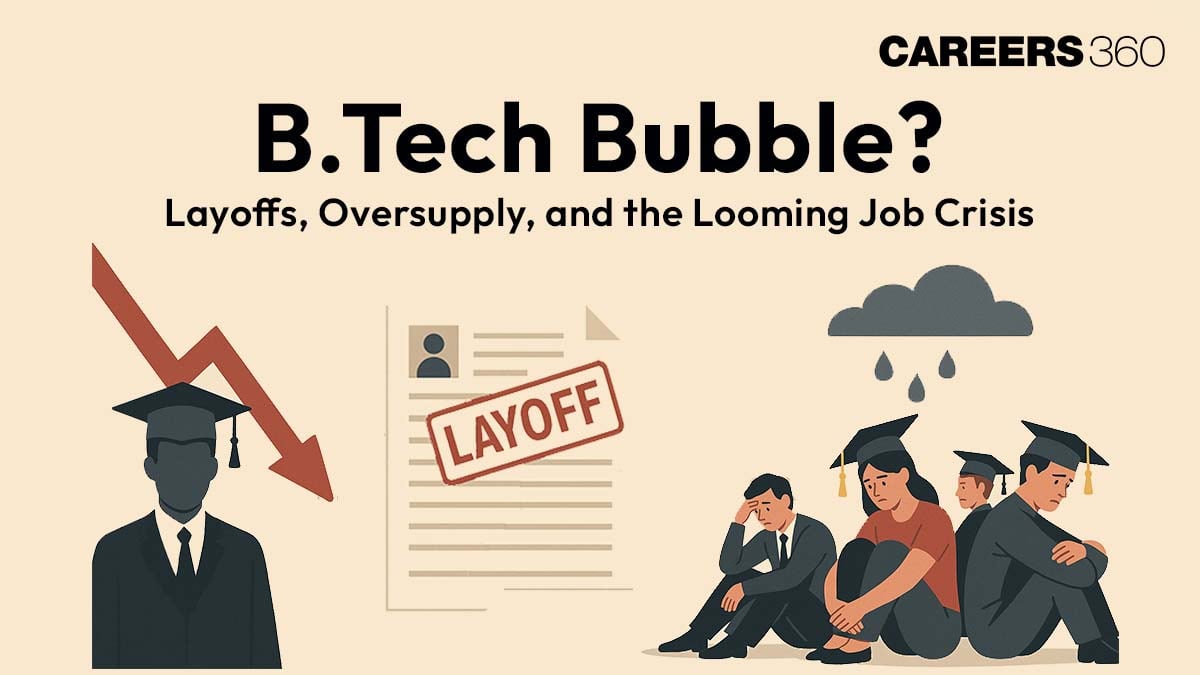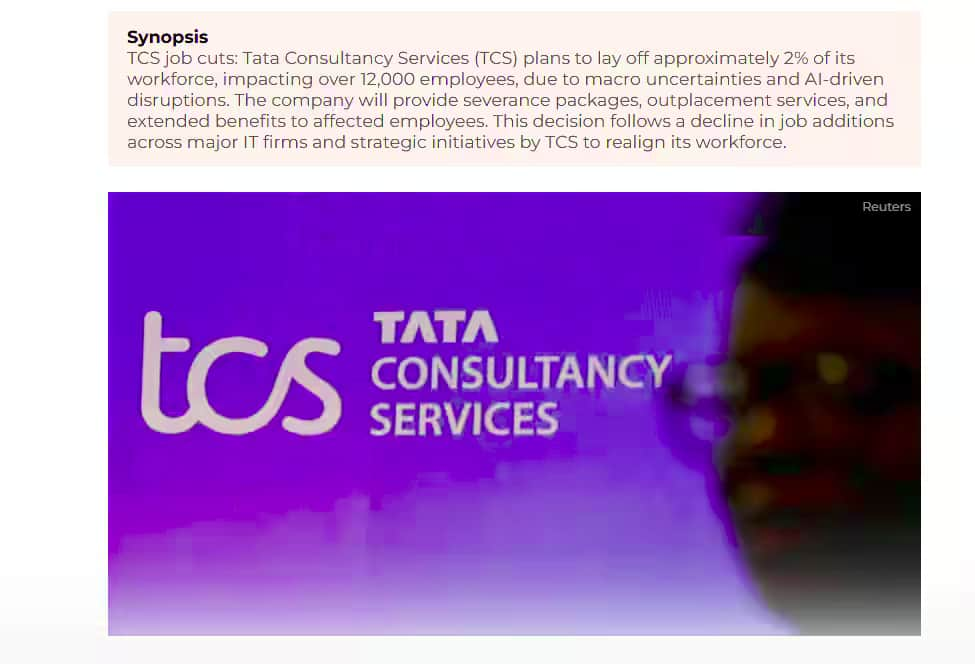India’s tech industry, once known for its rapid growth and large-scale job creation, is now facing a major shift. Recent layoffs by both Indian and global tech companies have raised serious concerns about the future of employment in this sector. While the supply of fresh engineering graduates is increasing every year, job opportunities have started shrinking at a feverish pace since 2023, —creating a worrying gap between education and employment.
This Story also Contains
- Growth of Engineering Colleges in India from 2012 to 2024
- Growth of Engineering & Technology UG Enrolments 2010-2024
- Computer Science & Engineering UG Program Enrolment 2010 to 2024
- Employee Growth of Top Indian IT Companies: 2010 vs 2025
- TCS Layoffs 12,000 Senior, Mid-Level Staffs
- IT Employment Growth Started Declining due to AI Adoption Increases
- Impact of Automation and AI on Tech Hiring
- The Changing Dynamics of Tech Hiring
- International Companies Laying off (with Indian presence)
- Advice for Students: Preparing for the New Tech Landscape

At the same time, artificial intelligence (AI) is changing the way the world works. Tech leaders like Nvidia’s CEO Jensen Huang and Elon Musk are encouraging students to move beyond traditional coding and focus on core subjects like physics. Their advice comes at a time when AI is increasing efficiency in companies—but also reducing the need for human workers.
Growth of Engineering Colleges in India from 2012 to 2024
Stream Name | 2012-13 | 2023-24 | % Growth |
Engg colleges | 3,371 | 8,876 | 163% |
According to AISHE survey, Between 2012-13 and 2023-24, the number of engineering colleges in India has nearly tripled — from 3,371 to 8,876, marking an impressive 163% growth. During a slightly broader timeline from 2010-11 to 2023-24, undergraduate enrolments across engineering and technology streams surged by 81%, from approximately 2.34 million to over 4.23 million students.
Growth of Engineering & Technology UG Enrolments 2010-2024
Stream Name | 2010-11 | 2023-24 | % Growth |
Engg & Tech | 23,40,506 | 42,37,421 | 81% |
Computer Science & Engineering UG Program Enrolment 2010 to 2024
Stream Name | 2010-11 | 2023-24 | % Growth |
4,75,870 | 21,62,266 | 354% |
Over the past decade, there has been a significant rise in engineering and technology education in India. From 2010–11 to 2023–24, overall enrolments in Engineering & Technology grew by 81%, increasing from 23.4 lakh to 42.3 lakh students. The most notable growth was seen in Computer Science & Engineering, where enrolments surged by 354%, rising from 4.75 lakh to 21.62 lakh students. This surge is not matched by increased demand for these graduates.
Employee Growth of Top Indian IT Companies: 2010 vs 2025
Driven by increasing demand for Indian companies as a great outsourcing destination for IT enabled services, Leading IT firms like TCS, Infosys, Wipro, Cognizant, and Accenture have expanded their workforce significantly since 2010 and have almost doubled and tripled their headcount. This also resulted in growth in revenues and profitability of these companies in the last two decades.
Company | Employee Count (2010) | Employee Count (2025) | Growth Percentage (%) |
Infosys | 1,27,779 | 3,17,240 | 153 % |
TCS | 1,60,429 | 6,06,998 | 278 % |
Wipro | 1,08,071 | 2,34,054 | 116 % |
Cognizant | 1,04,000 | 3,36,300 | 223 % |
Accenture | 2,04,000 | 7,99,000 | 291 % |
This growth reflects the expansion of the IT service ecosystem and the rising global demand for technology solutions provided by Indian Companies over this period.
TCS Layoffs 12,000 Senior, Mid-Level Staffs
However, the recent wave of layoffs, citing various reasons, shows a changing trend. Tata Consultancy Services (TCS), the country’s largest IT firm, is now reducing its global workforce by about 2%, impacting nearly 12,000 employees.


Inflation Nearly Doubled, Salaries Didn’t
It is worth a mention that in last two decades, while the ITeS companies employed more people, the salaries offered to campus freshers remained stagnant. This also led to the real income in the hands of a campus placed students becoming half of what it was in 2010. From 2010 to 2025, the Consumer Price Index (CPI) nearly doubled — rising from 100 to 197 — indicating a 97% increase in the cost of living. However, the salaries almost stagnated leading to a 49% to 60% decline in real income of fresh engineering graduates.
TCS | 2007 | 2025 | Difference Amount | Salary drop with respect to inflation % | % of salary drop with respect to inflation |
Assistant System Engineer | 3,15,787 | 3,36,875 | 7,89,467 | 4,73,680 | 60% |
Infosys | 2010 | 2025 | Difference Amount | Salary drop with respect to inflation % | % of salary drop with respect to inflation |
System Engineer - Trainee | 3,25,008 | 3,60,000 | 6,40,265 | 3,15,257 | 49% |
While salaries increased on paper, they fell in real value, leaving today’s freshers financially worse off than those 15 years ago.
IT Employment Growth Started Declining due to AI Adoption Increases
As explained earlier, India’s top IT companies saw remarkable employee growth from 2010 to 2025, adding lakhs of jobs and expanding their workforce globally. However, the story started changing in the last two years. Between 2023 and 2025, the same companies have recorded a decline in employee count. According to recent data:
Company | Headcount 2023 | Headcount 2024 | Headcount 2025 | % Growth (2023–2025) |
TCS | 6,14,795 | 6,06,998 | 6,07,979 | –1.11% |
Infosys | 3,43,234 | 3,17,240 | ~3,20,000 | –6.77% |
Wipro | 2,56,921 | 234,054 | 2,33,232 | –9.22% |
HCLTech | 2,25,944 | 2,27,481 | 2,23,420 | –1.12% |
Tech Mahindra | 1,52,400 | ~1,45,455 | 1,48,731 | –2.41% |
The drop in headcount across these major firms marks a significant shift. After years of strong hiring, companies are now tightening their workforce. The main reason behind this slowdown is the increasing adoption of Artificial Intelligence (AI) and automation.
AI tools and platforms are now capable of performing many tasks that previously required large teams of engineers. From software testing to routine coding and customer support, many processes have been automated. This has reduced the demand for entry-level and repetitive roles, leading to layoffs across the industry.Additionally, companies are focusing on efficiency. Clients now expect more work to be done with fewer people, pushing IT firms to adopt leaner operations.
While the overall growth from 2010 to 2025 remains impressive, the recent decline in hiring signals that the IT job market is evolving. Future opportunities will likely require advanced skills in AI, data science, cloud computing, and emerging technologies, rather than traditional IT roles alone.
Impact of Automation and AI on Tech Hiring
Cost optimization has become a major focus for IT companies when securing new deals. Clients are now demanding higher productivity, either by getting more work done with the same number of employees or by achieving the same results with fewer staff. The second approach is especially leading to layoffs, as companies struggle to redeploy surplus employees when demand slows down.
Roles that are rule-based, repetitive, and easy to automate are the most affected. This includes:
Test Engineers,
Application Testers,
QA Testers,
Software Test Engineers and
QA Engineers.
These positions, which are highly objective and process-driven, are increasingly being replaced or reduced through automation and AI tools.Currently, these roles make up 36% to 40% of the total talent pool in the IT sector’s Testing and QA/QC functions, putting a significant portion of the workforce at risk as companies continue to streamline operations for greater efficiency.
The Changing Dynamics of Tech Hiring
The tech hiring landscape is undergoing a major transformation driven by two key factors.
First, AI disruption is reshaping the industry. Entry-level, repetitive, and bench roles are becoming the most vulnerable to automation. As companies adopt AI and advanced technologies, they are consolidating teams and seeking professionals with modern skill sets such as AI, data science, and cloud computing.
Second, there is a noticeable softness in demand. “The trend of delays in decision-making and project starts with respect to discretionary spends has continued and intensified in this quarter," said CEO of TCS, Mr. K Krithivasan. Many companies are seeing a decline in client project inflows, especially from major markets like North America. This slowdown is leading to more cautious hiring practices and increased focus on efficiency.
Together, these trends are redefining how tech companies approach recruitment and workforce planning in today’s evolving market.
International Companies Laying off (with Indian presence)
It’s not just Indian IT companies facing workforce reductions—international tech giants with a significant presence in India are also downsizing.
In 2025, Microsoft announced over 15,000 layoffs globally, with 9,000 job cuts in July alone. Similarly, Amazon’s AWS division, despite strong revenue growth of around 17%, laid off hundreds of employees, including technical and support staff based in India, as part of broader cost-cutting linked to increased AI investments.
Google is also reducing its workforce this year, driven by the combination of advancing AI technologies and weakening demand. Meanwhile, Intel has already conducted layoffs across multiple U.S. locations, such as Oregon and California, and is planning further reductions as it shifts focus toward AI-based research and infrastructure.
These layoffs highlight how AI disruption and changing market dynamics are reshaping the global tech workforce, with India—being a major talent hub—feeling a significant impact.
Advice for Students: Preparing for the New Tech Landscape
It is not that the tech skills are disappearing—it’s simply changing. It is shifting. As AI and automation continue to reshape the industry, students must adapt their learning and career strategies to stay competitive.
Proof of Skills Over Paper Credentials: It would be more competitive to land a job in a good tech company. Students must stay ahead of the curve by skilling themselves. A mere paper credential of a B.Tech Degree may not work. Companies value practical skills and real-world experience more than just academic qualifications.
Start Early: Don’t wait until your final year to gain industry exposure. Internships, projects, and hands-on experience from the first year itself can make a big difference.
Diversify Your Skills: Blend domain knowledge with computer science skills. Explore global opportunities and remote work options to broaden your horizons.
Always Have a Backup Plan: Stay flexible. Build multiple skill sets so you can pivot if market demands change.
The Indian tech industry has experienced impressive growth over the past decade, but recent trends show that the landscape is evolving rapidly. AI and automation are driving significant shifts in hiring patterns, reducing demand for traditional roles while creating opportunities in new areas. Major Indian IT companies, along with global tech giants, are adjusting their workforce strategies to align with these changes.
For students and professionals, this is a critical time to adapt. Building relevant, future-proof skills, gaining continuous industry exposure, and staying flexible will be key to thriving in this new era of technology. The opportunities are still there—but they belong to those who are ready to evolve with the industry.
For those parents and students, who believe that a B.Tech degree will get them a job, this can be a wake up call. Adapt to the situation. Stay alert. Skill yourself. And start working on your Plan B. Because there is a distinct possibility that the B.Tech Bubble, especially for coding engineers, is about to burst!!
